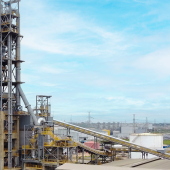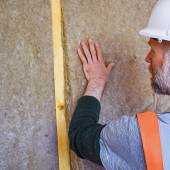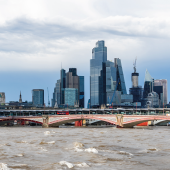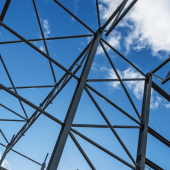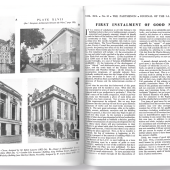The Effects Of Light Intensity And Temperature Towards East-West Orientation At Putrajaya Office Building, Malaysia
By Badrul Munir Daut, and Hazril Sherney Basher
School of Housing, Building, and Planning, Universiti Sains Malaysia (USM), Penang, Malaysia.
Abstract
Orientation is a factor that involves building design and contributes to good indoor lighting and thermal performance of space in a building. Due to the limitation of site constraint in urban areas, office building orientation tends to face east-west orientation and therefore most office indoor spaces received high indoor illuminance and existing glare problems. These problems also allow the contribution of heat gain into the building in the longer run. To overcome this problem, a solution is needed to investigate an effective design strategy by determining the best orientation among east and west. Several methods that involved literature studies, as well as observation and physical measurement, were conducted to fulfill this research. According to the preliminary findings, the surface temperature of the selected office building has a higher influence on the increasing amount of direct sunlight towards east and west facades. Besides, the research has found that the amount of direct sunlight that penetrates the facades may affect visual comfort and surface temperature. This research attempt to provide a better understanding and improve solutions to the building designer on how to further optimize the orientation of a building on the east and west façade.
Introduction
Before artificial lights were invented, sunlight was the major source for building lighting system. Daylighting physically has not changed since its original use and it is often to be integrated into a building design as an architectural statement for energy savings. generally, daylighting is good for the environment since the benefits of daylighting are beyond architecture and energy. Passive lighting is one of an architectural elements that totally use of sunlight to light spaces without using electronics. This light energy is essential in a building to improve energy saving, especially in daytime. The space of a building should provide an adequate opening for natural light and visual perception of the external environment to suit human comfort. This daylighting can improve energy savings in a building while reducing the consumption of artificial lighting. However, if not properly control, natural daylighting could adversely affect the ecosystem, as excessive solar yield will lead to the use of increasing artificial energy consumption for cooling purposes [1]. As Malaysia is designated as tropical climate region, hot and humid is the main climate throughout the year. All these elements of the climate will affect the design of a building. Due to the trajectory of the sun that runs from east to west, north and south elevation are considered the best orientation for a building in Malaysia, since solar radiation on the north and south orientation is lower compared to the east and west orientation due to the penetration direct sunlight. The orientation of the building is important since it is related to the shape in which a building is located and related to the arrangement of openings, ceilings, and other natural lighting features. Orientation is always the first strategy designed by the architect to promote a good penetration of daylight in a building. However, it will become worst when most of the site orientation is facing east and west axis. Direct sunlight can cause heat gain build up and contribute to the rising of surface and indoor temperature in a building. This happens especially in urban high-rise offices across Malaysia. According to Soori & Alzubaidi [2], whether natural or artificial, good lighting plays an important role in occupational health and safety, such as the office workplace. It helps the crew to reduce fatigue and discomfort that affected by the excessive of light intensity. Scientifically, the sunrise is on the east while sunset is to the west. Based on this theory, east and west orientation will provide the maximum numbers of natural lighting. But, based on the study by Sylvester K. Guth [3] visual comfort is the percentage of people that will find a certain viewpoint or direction and usually visual comfort is related to the light intensity of the surrounding that can affect visual discomfort and glare.
2. Methodology
In this paper, case study was conducted as first method into surveying high-rise offices which faces east and west orientations. This investigation is being carried led by discovering one (1) office building in Putrajaya, Malaysia where the criteria was met for building selection. There are few criterions of the selection for the office building. As a start the office building must be facing both the east and west axis. The location is in the heart Putrajaya town center. Moreover, the high-rise office building must allow good sunlight penetration for both orientations and is cleared by any obstacles from the adjacent buildings or surrounding. Apart from that, the building must façade treatment such as shading device and without shading device on both orientations. Thus, ‘Suasana’ PJH office building Putrajaya was selected (Figure 1). The natural daylighting in ‘Suasana’ PJH office building, Putrajaya provide an optimum lighting system during the office hours during data collection. The second methodology conducted was the field measurement. As a preliminary study, this paper focuses on two parameters which is the lux intensity and the surface temperature. Both orientations for east and west axis were measured with 1-hour intervals between 9:00am and 12:00pm for east orientation. While west orientation was measured between 12:00pm and 5:00pm instantaneously. Both orientations represent the worst-case scenario for east and west axis as a benchmark which were depends on morning sunlight and evening sunlight. Besides that, due to limitations of accessing the office spaces the readings were taken at morning session and evening session for 3 clear days [4]. The instruments used for this data collection were the Hanna Lux Meter and IrTek Infrared Thermometer (Figure 1).
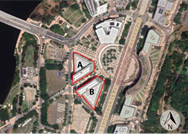
Figure 1: a) Location of ‘Suasana PJH Office Building, b) Typical Plan for Measurement Area, c) Data Collection Instrument.
3. Results and Discussion
3.1 East orientation on morning sunlight by comparing with shading device and no shading device.
Figure 2 shows the comparison data values of light intensity and surface temperature by using shading device and without shading device for east orientation. From the figure 2 it shows that the graph pattern for both surface temperature and light intensity are in line. The trend from the surface temperature readings indicated that both without shading device and with shading device is gradually increased from 9:00am and suddenly fall after 11:00am. While the trend of light intensity for both conditions also decreases after 11:00am respectively. The maximum surface temperature ever recorded occurred in day 1 and day 3 with readings reached to almost 36. 2°C.This is the existing condition without any shading device, and during this time the lux intensity was estimated at 1660 lux. Comparing to the condition with shading device the readings showed significant surface temperature drop with reading fall to almost 34.4°C. At this point the shading device for east orientation was able to reduce at least 1. 8°C.In terms of light intensity, the shading device could block the sunlight to an average reading of 1533 lux. The differences were estimated at 127 lux by comparison.
Figure 2: East orientation lux intensity and surface temperature (with and without shading device).
3.2 West orientation on evening sunlight by comparing with shading device and no shading device.
Figure 3 shows the comparison data values of light intensity and surface temperature by using shading device and without shading device for west orientation. Based on this 3, it can be identified that the trend of this graph for both surface temperature and light intensity are slightly increasing compared to east orientation. The pattern of surface temperature for without shading in this orientation reached to maximum reading of almost 37.5°C on the day 1. The average maximum reading was estimated at 36.0°C. At this point it occurred mostly after 5:00pm. The surface temperature trend for with shading device also indicated a rising trend as most of the readings rose gradually until reaching 34.0°C. The differences between with and without shading devices for west orientation was at least 1.8°C and it was the same with temperature difference occurred in east orientation as well. In terms of lux intensity, the maximum reading reached at least 1626.7 lux which is 94lux increased compared to east orientation. The lux intensity increased by hours and gradually showed a stagnant reading when reached at 5:00pm. Although the sunlight intensity was greater when it was without shading device, both condition of without and with devices shows similar and closing gap pattern when reached at 4:00pm onwards.
Figure 3: West orientation lux intensity and surface temperature (with and without shading device).
6. Conclusion
In this paper, the results had shown that the east sun penetration has a higher average reading of 1594 lux on sunlight intensity in the morning session between 9.00am and 12.00pm compared to the west sun penetration with average reading of 1449 lux. During this time, it occurred in the evening between 1.00pm and 5.00pm respectively. Overall, the average difference of direct sunlight intensity is estimated at144 lux. However, the sunlight intensity on the east and west orientation still exceeds the comfort value of luminance for the field of view in an office building. According to NUTEK [5], the luminance values of office space must be kept below 1000 lux (preferably below 500 lux) in the normal field of view. The recommended luminance of the surface should not more than 1500 lux, whereas the computer works, and screen surfaces are preferably below 500 lux. Even though there are differences in sunlight intensity between east and west building orientation, the sunlight intensities are too high and can cause visual problems such as sun glare. Apart from that, the east orientation could allow a higher surface temperature heat gain buildup of the office building. Based on the readings in figure 2 and 3 the surface temperature of the ‘Suasana’ PJH building façade was influenced majority by the luminance value of direct sunlight towards both building orientations. When the luminance of sunlight intensity is higher, the surface temperature of the office building façade is also higher as the sunlight transfers heat into the building. As stated in the figure 2 and 3, the surface temperature of east orientation direct sun penetration is higher than the average surface temperature of west orientation. However, the indoor temperature is not mostly influenced by the level of direct sunlight intensity but according to the collection of data, the indoor temperature of the office building was gradually increased from the morning sun to the evening sun. The heat transfer from the morning sun will be released from the building on the evening due to the climatic factor [6]. The data collected according to the installation of the shading device (Figure 4) shows that the reading of direct sunlight intensity can significantly drop between 200 lux and 300 lux if the shading device system were installed. However, the sunlight intensity on the east and west orientation still exceeds the comfort value of luminance for the field of view in the office building space which is not more than 1000 lux and preferably 500 lux for comfortable conditions.
Figure 4: Suasana PJH Office Building (left) and With and Without Shading Devices on The Office Building Facades
When comparing both orientation with and without shading devices it can be summarized that the lux intensity readings for east orientation façade was greater than the west orientation. However, it showed a declining trend when reached at 12:00pm onwards. For west orientation, the lux intensity keeps climbing gradually until it reached to a stagnant point at 5:00pm. The surface temperature trends for east and west orientation has a slightly different trends when compared side by side. From the result it can be concluded that the west orientation has a slightly higher temperature build up when facing the west orientation. It can be notified that the reading on the west orientation reduced minimal temperature drop even when applied with shading devices on the office facade. Moreover, the increasing surface temperature of west orientation could be affected by the thermal storage absorbed from receiving morning sunlight throughout the day. Therefore, this research shows that for future recommendation on designing a better high-rise, designer needs to cater alternative solutions of blocking east orientation compared to west. A strategy on façade design towards east and west building orientation is needed for future recommendation of work to reduce issues relating with temperatures and sun glare. As for now one of the recommendations to be installed on high- rise offices besides horizontal shading device are the combination of both horizontal and vertical fins with louvers. The solution of having egg crate devices (combination of horizontal and vertical) could be the best approach to lower the internal surface temperature and to reduce the inconvenience solar radiation penetrating from different angles of the sun in the equatorial region [7].
7. References
1. Gago, E. J., Muneer, T., Knez, M., & Köster, H. (2015). Natural light controls and guides in buildings. Energy saving for electrical lighting, reduction of cooling load. Renewable and Sustainable Energy Reviews, 41, 1–13. https://doi.org/10.1016/j.rser.2014.08.002
2. Soori, P. K., & Alzubaidi, S. (2011). Study on improving the energy efficiency of office building’s lighting system design. 2011 IEEE GCC Conference and Exhibition, GCC 2011, 585–588. https://doi.org/10.1109/IEEEGCC.2011.5752604
3. Eastman, A. A., Guth, S. K., & Brecher, G. A. (1963). Instrument with variable beam splitter for measuring contrast sensitivity. Investigative Ophthalmology and Visual Science, 2(1), 37–46.
4. Dahlan, N., Jones, P.J., Alexander, D.K., Salleh, E. & Dixon, D. (2008). Field measurement and subjects votes assessments on thermal comfort in high rise hostels in Malaysia. Indoor and Built Environment, 17(4), 334-345.
5. NUTEK. (1994). Programkraf: belysning pa kantor. Programkrav for god och energieffektiv belysning pa kantor. 1994 – 11. Utgava 2. NUTEK. Stockholm (Sweden).
6. Claesson, J., & Hagentoft, C. E. (1991). Heat loss to the ground from a building—I. General theory. Building and Environment, 26(2), 195-208
7. Al-Tamimi, N. A., & Fadzil, S. F. S. (2011). The potential of shading devices for temperature reduction in high-rise residential buildings in the tropics. Procedia Engineering, 21, 273–282. https://doi.org/10.1016/j.proeng.2011.11.2015
Authors Biography
Badrul Munir Daut is a Master Architecture student in Architecture Programme at the School of Housing Building & Planning, Universiti Sains Malaysia (USM), Penang, Malaysia.He got his Bachelor of Science degree (hons.) Architecture in Universiti Sains Malaysia & presently completing his Master’s Architecture Coursework programme.
Hazril Sherney Basher is a Senior Lecturer in Architecture Programme at the School of Housing Building & Planning, Universiti Sains Malaysia (USM), Penang, Malaysia. He obtained his PhD & Master’s degree in Built Environment (Architecture) from University Technology Mara (UiTM) Shah Alam, Malaysia & Universiti Sains Malaysia (USM) Penang, Malaysia. Before joining USM as a lecturer he has worked with Arkitek ATMA Sdn. Bhd. as a Consultant Architect and completed several projects. His research focuses on Bio-façade & Urban Greening, Building Thermal Performance, Building Energy Simulation & Sustainable Building Design.
This research paper was presented at the 2021 CABE Malaysia Chapter online Conference.


